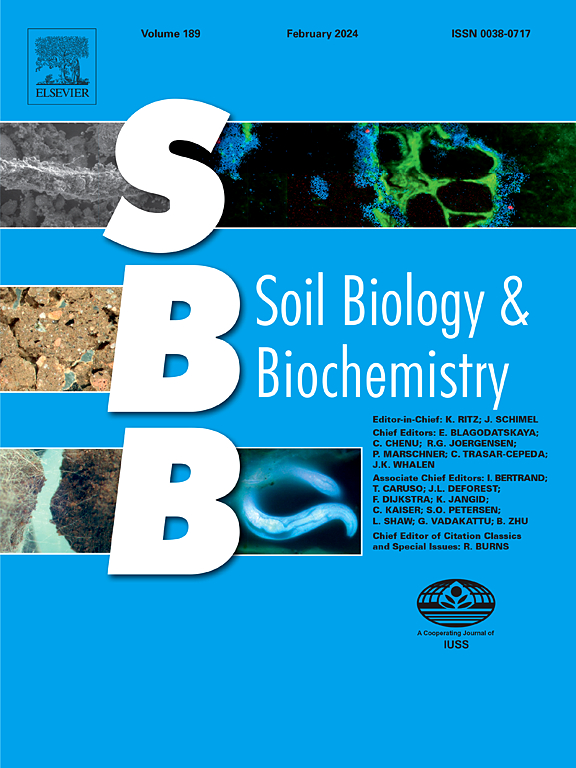高寒生态系统土壤持久性有机碳损失机制:微生物和钙空间足迹的洞察
IF 10.3
1区 农林科学
Q1 SOIL SCIENCE
引用次数: 0
摘要
土壤持久性有机碳(OC)是一种古老的、以前未量化的全球碳汇。然而,该库及其功能成分易受全球变化影响的机制仍不清楚,尤其是在热液资源受限的高山生态系统中。在这里,我们采用低温灰化(模拟碳的自然氧化过程)和 18O-H2O 培养方法,探索了高山草甸与高山大草原因气候变暖和氮(N)沉积而造成的持久性 OC 损失的不同机制。我们观察到草甸土壤的持久性 OC 显著下降,其中氮添加(-22%)造成的下降幅度最大,其次是气候变暖(-8%)。然而,气候变暖(-16%)抵消了氮添加(+15%)对草原持久性有机碳的积极影响。持久性有机碳的这种动态变化与矿物相关有机碳(MAOC)密切相关,但与颗粒有机碳(POC)无关。在草甸土壤中,氮的添加降低了 23% 的 MAOC,这可能是通过降低土壤 pH 值和抑制钙(Ca)架桥及其通过微团聚体的物理保护作用实现的。在干草原土壤中,MAOC 的减少(-29%)主要是由于气候变暖导致的土壤湿度限制,这反过来又抑制了微生物的生长并延长了周转时间,从而限制了微生物坏死物质 C 的形成。总之,气候变暖和氮添加对微生物和钙足迹造成了空间限制,这分别是高山草原和草甸中 MAOC 损失的原因,并可能影响更广泛地区的土壤钙持久性。本文章由计算机程序翻译,如有差异,请以英文原文为准。


Mechanisms of soil persistent organic carbon loss in alpine ecosystems: Insights into microbial and calcium spatial footprint
Soil persistent organic carbon (OC) constitutes an ancient, previously unquantified global C sink. Yet, the mechanisms underlying the vulnerability of this pool and its functional components to global change remain unclear, especially in hydrothermal resource-restricted alpine ecosystems. Here, employing low-temperature ashing (mimics C natural oxidative processes) and 18O–H2O incubation, we explored the differential mechanisms underlying the persistent OC loss caused by warming and nitrogen (N) deposition in alpine meadow versus alpine steppe. We observed a substantial decline in persistent OC of meadow soils, with N addition (−22%) exerting the largest decline, followed by warming (−8%). However, warming (−16%) negated the positive effects of N addition (+15%) on steppe persistent OC. Such dynamics in persistent OC were strongly linked to mineral-associated OC (MAOC) but not to particulate OC (POC). In meadow soils, N addition decreased MAOC by 23%, likely by reducing soil pH and suppressing both calcium (Ca) bridging and its physical protection via microaggregates. In steppe soils, the reduction in MAOC (−29%) was primarily due to warming-induced limitations in soil moisture, which, in turn, constrained the formation of microbial necromass C by suppressing microbial growth and lengthening turnover. Collectively, warming and N addition imposed spatial constraints on microbial and Ca footprint, which underlie the loss of MAOC in alpine steppe and meadow, respectively, and might affect soil C persistence more widespread.
求助全文
通过发布文献求助,成功后即可免费获取论文全文。
去求助
来源期刊

Soil Biology & Biochemistry
农林科学-土壤科学
CiteScore
16.90
自引率
9.30%
发文量
312
审稿时长
49 days
期刊介绍:
Soil Biology & Biochemistry publishes original research articles of international significance focusing on biological processes in soil and their applications to soil and environmental quality. Major topics include the ecology and biochemical processes of soil organisms, their effects on the environment, and interactions with plants. The journal also welcomes state-of-the-art reviews and discussions on contemporary research in soil biology and biochemistry.
 求助内容:
求助内容: 应助结果提醒方式:
应助结果提醒方式:


